index[Calixto][Description] [Axolotl FAQ]  [My Axolotls] [Habitat] [Feeding] [Health] [References] [Links] [Genetics] contactaxolotls@yahoo.com-or- Sign The Guestbook version92.12.02visitstravelDa Homepagelegal© 1996-1998Chris Eng All Rights Reserved 
|
Establish Your Tank With BacteriaIf you are planning on obtaining an axolotl, make sure you introduce them into an established tank. An established tank is one, where an effective nitrogen cycle is active within the tank. The nitrogen cycle is the process of converting ammonia down into less harmful nitrogenous compounds. The nitrogen cycle is activitated by established colonies of specialized bacteria that "live" on your filter's media (foam, ceramic pre-filters et cetera.) These bacteria convert the ammonia waste from the axolotls NH3 into Nitrite NO2- then into Nitrate NO3- These special bacteria are ubiquitous and will eventually establish themselves in your filter without any interaction on your part. However, ammonia must be present in the tank before the bacteria decide to take residence. A cloudy tank, after a water change, usually means that your filter is not established yet. An excellent resource on "establishing" your new tank is the Nitrogen Cycle section of the rec.aquaria FAQ.Tank SetupAt a minimum, one juvenile axolotl will do fine in a 5 gallon tank. However, I recommend a ten gallon tank for one adult axolotl. The carrying capacity for a standard ten gallon tank would be three adults. I always recommend a larger tank because axolotls will pinball around the tank. The height of the standard fish tank is overkill for axolotl keeping. Therefore, I usually keep the water level at 60-70% volume.Native HabitatUnlike terrestrial salamanders who thrive at 75ºF, axolotls naturally come from a series of Snow-melt fed lakes southeast of Mexico City. More of a problem is keeping then tank cool enough for them. See Axolotl HealthEndangered SpeciesAxolotls are in danger of being extinct in their native habitat (Lake Xochimilco and Lake Chalco near Mexico City). These are areas confined to altitudes over 1600 meters. Shaffer writes:These lakes share a number of features in common. First, they are all large, relatively permanent bodies of water (or at least they used to be before the intervention of man). Second, they are situated in dry areas, and in many cases are the only permanent, aquatic environment in the region. And third, they all historically lacked large, predatory fishes (although this too has changed recently) Metamorphosis and NeotenyIn regards to their neoteny or metamorphic failure, he notes:In general, the explanation that has gained widest acceptance for the high levels of metamorphic failure in this region has been that the lakes represent a stable, benign, aquatic habitat in the midst of a relatively harsh environment. For ambystomatids, it appears that the simples way to exploit these habitats is to avoid metamorphosis altogether, and to reproduce simply as axolotls. Artificially Induced MetamorphosisLaboratory experiments have been done to see whether axolotls use metamorphosis to deal with environmental change. Axolotls that have the genes to undergo metamorphosis can be readily do so with an injection of T4 thyroxin. Thyroxin is a hormone that causes maturation in most vertebrates. Forcing natural metamorphosis by reproducing drought conditions, increasing salinity, et cetera, have been largely unsuccessful.Hormone RegulationFor some axolotls, thyroid metamorphosis is impossible. Other axolotls, who have the capability to transform, can do so in under a month by being immersed in solution of triiodothronine (T3). Other methods included the introduction of thyroxine (T4) or thyrotropin hormones (TSH) into the axolotl.Water ChemistryFor the captive axolotl keeper, heaters are absolutely not necessary in an axolotl tank, keeping the water cool is a main priority. Axolotls in their native habitat live in temperatures of 60-68ºF with a pH between 7.4-8.2.PrecautionsIf you use a filter, make sure that the intake tube is hidden behind rocks or somewhere their gills will not get sucked into. Most people use gravel on the bottom of their tanks. I do not recommend this because they have a tendency to swallow the gravel during feeding sessions. I do not believe this is good for their digestive tract! One week after I brought Artemis home, I noticed many pieces of blue gravel that he passed which he had digested earlier at the pet store. I currently use Mexican river rocks (1"-1½" in diameter). They are very smooth, and the axolotls use them to rest or stand up upon.Functional OrnamentalsFor my baby axolotls, I cover the top of the tank with a dense array of plastic plants, without the base. This allows the plants to bunch up and form a network on the upper water column. The young axolotls float up to the plants, and stay in the protective cover until it is feeding time. When it is feeding time, they descend to the bottom of the tank and gorge themselves silly. After that, it is back to the top for some rest and relaxation. As the axolotls get over three or four inches long, they will start to stay on the bottom of the tank. |
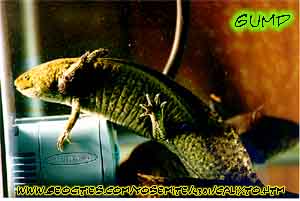  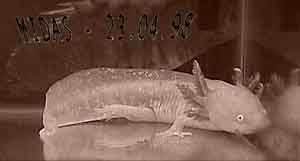 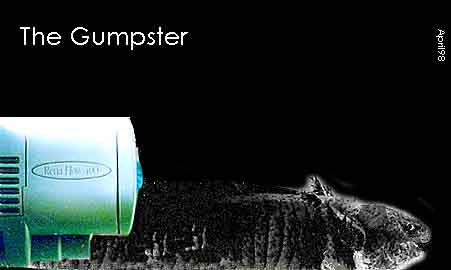 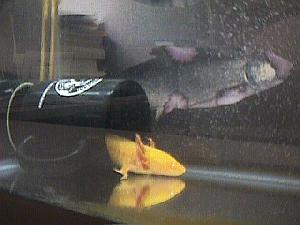 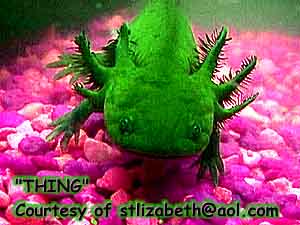 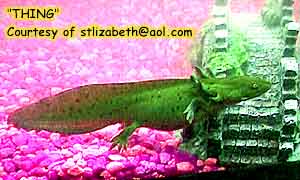 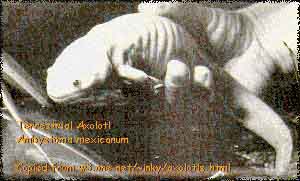 |